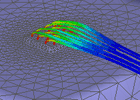




















|
|
Aerosol Kinetics Particle Path For constant fluid velocity, integrating Equation 5, the position of the particle is given by
Here |
|
|||||||||||

| (12) |

| (13) |
where the ration of the terminal velocity to the fluid velocity α is given by

| (14) |


| (15) |
That is the particle paths are straight lines. Figure 3 shows sample particle trajectories.




 is the initial position of the particle.
For a particle starting from rest, when
the fluid velocity is in the x-direction and gravity is in the negative
y-direction Equation 10 reduces to
is the initial position of the particle.
For a particle starting from rest, when
the fluid velocity is in the x-direction and gravity is in the negative
y-direction Equation 10 reduces to
